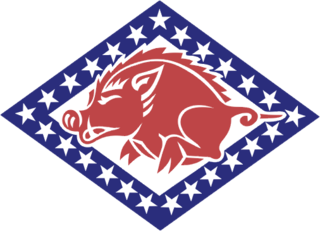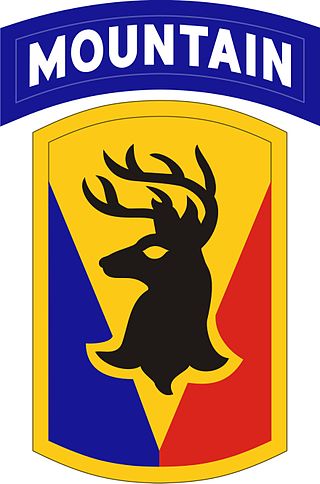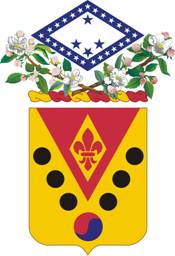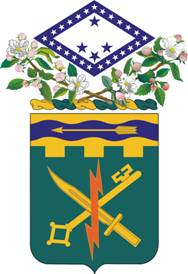
The 39th Infantry Brigade Combat Team, also officially known as The Arkansas Brigade, is an infantry brigade combat team of the Army National Guard composed of personnel from the U.S. states of Arkansas, Missouri, and Nebraska. The unit is the largest Army National Guard command in Arkansas and is headquartered at the Camp Robinson Maneuver Training Center. It was ordered into federal service in 2003 in support of Operation Iraqi Freedom II. The 39th was attached to the 1st Cavalry Division and served in and around Baghdad for a year, returning to the United States in March 2005.

The 135th Aviation Regiment is an Aviation Branch regiment of the United States Army, first formed in August 1985.

The 45th Infantry Brigade Combat Team ("Thunderbird") is a modular infantry brigade combat team of the United States Army headquartered in Norman, Oklahoma. It is a part of the Oklahoma Army National Guard.

Below is an estimated list of the major units deployed within the Multi-National Force – Iraq and other United States military units that were operating in Iraq under the U.S. Central Command (USCENTCOM) in 2009, during the Iraq War.

Camp Taji, also known as Camp Cooke, is a military installation used by Iraqi and Coalition forces near Taji, Baghdad Governorate, Iraq. The camp is located in a rural region approximately 27 km (17 mi) north of the capital Baghdad.

The Arkansas Army National Guard (ARARNG) is a component of the Arkansas National Guard and the United States National Guard. National coordination of various state National Guard units are maintained through the National Guard Bureau.

The 37th Infantry Brigade Combat Team (Buckeye) is an infantry brigade combat team of the United States Army National Guard with the brigade headquarters, cavalry squadron, field artillery battalion, engineer battalion, one infantry battalion, and support battalion stationed in Ohio, one infantry battalion and military intelligence company stationed in Michigan, and a third infantry battalion stationed in South Carolina. The headquarters of the 37th IBCT traces its lineage and honors back to the headquarters of the 37th Infantry Division.

The 3rd Brigade Combat Team, 1st Cavalry Division is a combined arms armored brigade of the 1st Cavalry Division based in Fort Cavazos, TX. Major equipment includes the M1A2SEP Tanks, M2A3 & M3A3 Bradley infantry fighting vehicles, M109A7 Paladin howitzers, and M1114 up-armored Humvees.

The 86th Infantry Brigade Combat Team (Mountain) ("The Vermont Brigade") is an Army National Guard light infantry brigade headquartered in Vermont. It was reorganized from an armored brigade into an Infantry Brigade Combat Team (IBCT) as part of the United States Army's transformation for the 21st century. The 86th IBCT utilizes the Army Mountain Warfare School, co-located at Ethan Allen Firing Range in Jericho, Vermont, to train in individual military mountaineering skills so the entire brigade can be skilled in such warfare. This large conventional unit level mountain warfare capability had been lost when the 10th Mountain Division deactivated after World War II. This left the 86th IBCT as the only mountain warfare unit in the U.S. military whose soldiers were trained in mountain warfare, with individual soldiers being graduates of Ranger School, the Special Forces Advanced Mountain Operations School, and the Army Mountain Warfare School instead of entire units that specialized in such tactics. "The Vermont Brigade" configured itself to be such a unit.

The 142nd Field Artillery Regiment is a United States Army field artillery regiment currently represented in the Arkansas Army National Guard by the 1st Battalion, 142nd Field Artillery, headquartered in Bentonville, Arkansas; 2nd Battalion, 142nd Field Artillery, headquartered in Barling, Arkansas; and Battery F, 142nd Field Artillery stationed in Fayetteville, Arkansas, elements of the 142nd Field Artillery Brigade which is headquartered in Fayetteville, Arkansas. The regiment was created in 1917 from the former 2nd Arkansas Infantry. The 142nd Field Artillery shipped to France during World War I but did not see combat before the cessation of hostilities. The regiment was activated for World War II, but its battalions were redesignated as separate battalions, 1–142nd became the 936th Field Artillery Battalion, the 2–142nd became the 937th Field Artillery Battalion. The battalion's served throughout the European Theater of Operations. The battalions were activated again for the Korean War and served throughout the war. Following the Korean War, the separate battalions resumed their former designations of 1–142nd FA and 2–142nd FA. The 142nd Field Artillery Brigade, including both battalions, was activated for Operation Desert Storm. Elements of the 142nd Fires Brigade have been activated for service in Operation Noble Eagle and Operation Iraqi Freedom. The 142nd Fires Brigade was instrumental in support and recovery operations located in New Orleans, Louisiana after hurricanes Katrina and Rita devastated the Gulf Coast.

The 53rd Infantry Brigade Combat Team is an infantry brigade combat team of the Florida Army National Guard. The 53rd Infantry Brigade is the largest National Guard unit in the state of Florida. The brigade was one of fifteen enhanced readiness brigades, designed and trained to support active duty divisions. The brigade includes 32 units in Florida and Alabama with 4,166 authorized personnel.

The 225th Brigade Support Battalion is a United States Army unit based at Schofield Barracks, Hawaii. It is part of the 2nd Infantry Brigade Combat Team, 25th Infantry Division.

The 206th Field Artillery Regiment is a United States artillery regiment, currently represented in the Arkansas Army National Guard by the 1st Battalion, 206th Field Artillery, Headquartered at Russellville, Arkansas. The 1–206th FA is an element of the 39th Infantry Brigade Combat Team.

The 153d Infantry Regiment is a United States infantry regiment, currently represented in the Arkansas Army National Guard by the 1st Battalion, 153rd Infantry, headquartered at Malvern, Arkansas, and 2nd Battalion, 153rd Infantry, headquartered at Searcy, Arkansas, elements of the 39th Brigade Combat Team. The regiment was also represented by the 3rd Battalion, 153rd Infantry Regiment headquartered at Warren, Arkansas until that unit was deactivated on 5 September 2005. The regiment was activated as the 1st Arkansas Volunteer Infantry for the Spanish–American War, but did not deploy overseas. The regiment was activated for World War I, redesignated as the 153rd Infantry and shipped to France as a part of the 39th Division, but became a replacement division and personnel were reassigned to other AEF units. The regiment was activated for World War II and deployed to the Aleutian Islands, participating in the Aleutian Islands Campaign. Recently, elements of the regiment have participated in two deployments in support of Operation Iraqi Freedom, in 2004 and again in 2008.

The 151st Cavalry Regiment was a United States Army cavalry regiment represented in the Arkansas Army National Guard by 1st Squadron, 151st Cavalry Regiment, headquartered in Warren, Arkansas, an element of the 39th Infantry Brigade Combat Team.

The 1st Battalion, 153d Infantry Regiment , is an infantry battalion of the Arkansas Army National Guard, headquartered at Malvern, assigned to the 39th Infantry Brigade Combat Team. The 1–153rd has deployed companies in support of the Multi-National Security Force to Bosnia and to Saudi Arabia as part of Operation Southern Watch. 1st Battalion, 153rd Infantry has twice deployed as a battalion for Operation Iraqi Freedom, once from 2004–05 and a second time in 2008. The battalion was awarded the Meritorious Unit Citation for the period, 17 March 2004 – 23 March 2005.

The 2d Battalion, 153d Infantry Regiment , is an infantry battalion of the Arkansas Army National Guard, headquartered at Searcy, assigned to the 39th Infantry Brigade Combat Team. During World War II, the battalion was stationed in the Aleutian Islands. Following the attacks of 11 September 2001, the 2nd Battalion, 153rd Infantry, nicknamed the "Gunslingers", deployed to the Sinai on a peace keeping mission in order to free regular army soldiers for service elsewhere. The soldiers of the 2–153rd deployed under the flag of the 3rd Battalion, 153rd Infantry during Operation Iraqi Freedom II. The battalion provided disaster relief operations to the citizens of Louisiana in the aftermath of Hurricane Katrina. The Gunslingers were deployed to Iraq a second time in 2008 as a security forces battalion and conducted convoy security operations in western Iraq. Most recently, members of the 2-153rd deployed to Central America as part of the Regionally aligned forces mission in order to carry out a train-the-trainer and security cooperation mission in Guatemala, Honduras and El Salvador. See also

3rd Battalion, 153rd Infantry Regiment was a United States infantry battalion, headquartered at Warren, Arkansas, assigned to the 39th Infantry Brigade Combat Team of the Arkansas Army National Guard until it was deactivated on 5 September 2005. The history of the 3rd Battalion, 153rd Infantry as an individual battalion begins with the reorganization of the 39th Infantry Division in 1967 and the creation of the 39th Infantry Brigade (Separate). For history of the 3rd Battalion prior to 1967, see 153rd Infantry Regiment and 39th Infantry Division.

The 39th Infantry Brigade Combat Team's Special Troops Battalion was headquartered in Conway, Arkansas and was an element of the Arkansas Army National Guard. On 15 September 2018, the 39th Special Troops Battalion was reflagged as the 239th Brigade Engineer Battalion, an element of the 39th Infantry Brigade Combat Team.

First Squadron, 153rd Cavalry Regiment "Darkhorse" is an element of the Florida Army National Guard, headquartered in Panama City, Florida with units throughout the Panhandle. It was formerly 3rd Battalion, 124th Infantry and officially converted to cavalry on 1 September 2007 when the 53rd Infantry Brigade converted from a "separate brigade" to the brigade combat team structure.












































